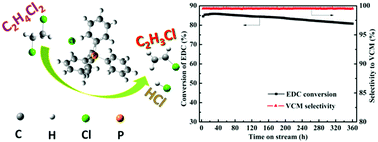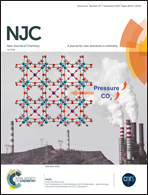Dehydrochlorination of 1,2-dichloroethane over a tetraphenylphosphonium chloride-supported carbon catalyst†
Abstract
Aiming to explore promising catalysts with superior anti-coking properties for the 1,2-dichloroethane (EDC) dehydrochlorination reaction, we prepared several activated carbon (AC)-supported high-melting-point quaternary phosphonium salt (QPS/AC) catalysts through the incipient wetness impregnation technique. After comparing the catalytic activities of these QPS/AC catalysts for EDC dehydrochlorination, we selected the activated carbon-supported tetraphenylphosphonium chloride catalyst (TPPC/AC) as the research subject because it had the highest catalytic activity. Activity evaluation results demonstrate that the optimum catalyst loading of 15%TPPC exhibits outstanding catalytic activity (acetylene conversion of 85.9%) and stability (deactivation rate of 0.014% h−1). Through BET, TG and TPD characterizations, it is shown that 15%TPPC/AC can promote the desorption of C2H3Cl and retard the desorption of HCl. These special adsorption and desorption properties of 15%TPPC/AC can be attributed to its excellent anti-coking capacity, which ensures its long-term stability in the EDC dehydrochlorination process. In combination with density functional theory (DFT) calculations, it is indicated that the TPPC can activate the C–H bonds of EDC molecules and dramatically decrease the activation energy of the reaction, consequently enhancing the EDC dehydrochlorination reaction.



 Please wait while we load your content...
Please wait while we load your content...